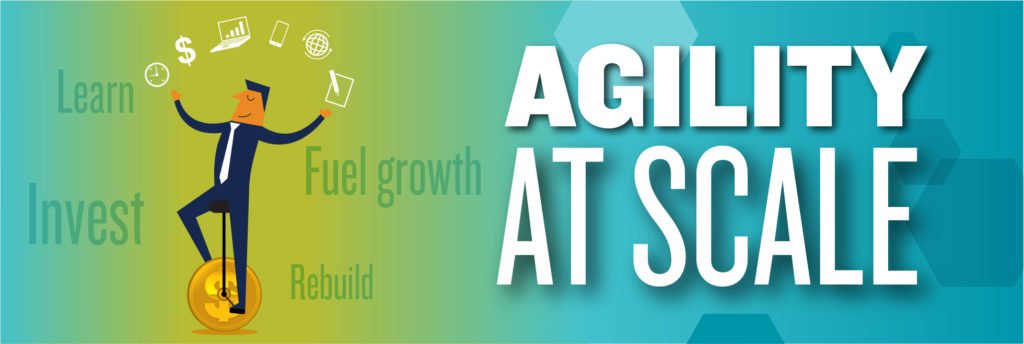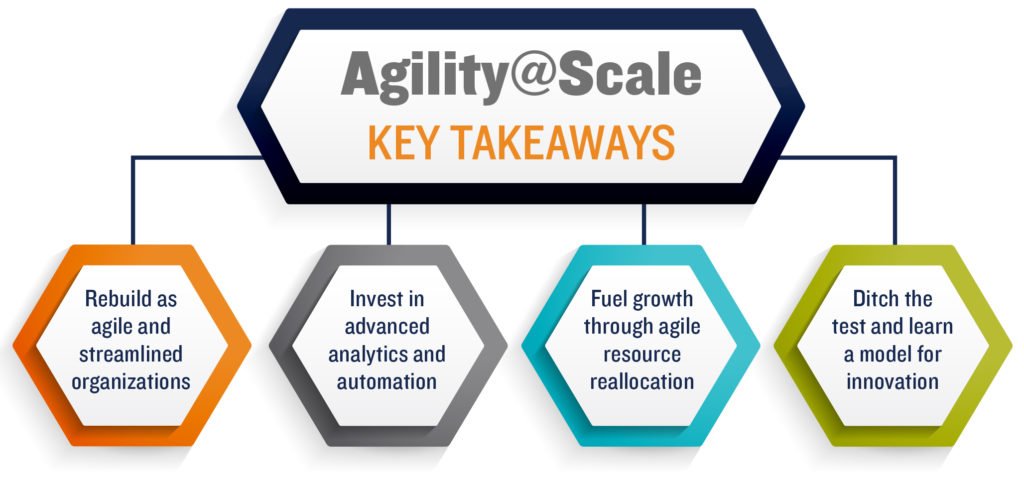
We recently found another wonderful article that the McKinsey team, specializing in FMCG, put together. “Agility@Scale: Solving the growth challenge in consumer packaged goods” defines how to overcome the uphill battle many FMCG categories and their manufacturers currently face. The answer is a combination of what the McKinsey team calls greater agility and new types of scale advantage aligned with the changing consumer, channel, and competitor landscapes. These team members define six different dimensions of Agility@Scalethat align quite closely with what we believe at Middlegame and corresponds with how we regularly try to help our clients make better marketing decisions.
The article explains that scale was a main focus in the past. In the foreground, large multinationals controlled the messages that consumers heard and the shelves that shoppers found in retail outlets. Behind the scenes, these same organizations dominated the supply chain. Subsequently, investment was all about the go-to-market efficiencies associated with their “mass-appeal”brands. Consumer preferences have since changed. The web has democratized messaging and given users the upper-hand at presenting content. There has also been a proliferation of channel options. These include ecommerce while advances in manufacturing automation and global logistics have rewritten the supply chain playbook. In turn, mass-appeal brands have lost their lustre.

A new marketplace has very different needs and wants. Here are a few points in the McKinsey article that we completely agree with:
Rebuild as agile and streamlined organizations:We regularly explain how our analytical approach is meant to quickly pivot across the vantagepoints of the various stakeholders. Requiring input from of all these different points of view often bogs decision making. It can also lead to compromises that are detrimental to the overall system. We see this time and time again for assortment, pricing, and merchandising opportunities that are truly win-win. However, McKinsey recommends dismantling complex matrix structures that diffuse ownership and bring decision making to a standstill.
Invest in advanced analytics and automation: Middlegame rarely gets to fully demonstrate how our platform integrates historical data, statistical modeling, and scenario planning to quickly produce a series of strategic options. Although we offer a scientific foundation that still allows marketing managers to be creative and apply their art, we often see our prescriptive analytic capabilities relegated to being merely descriptive “report card” generators. However, McKinsey recommends applying a new way of thinking where tools like CIA®help to define opportunities, evaluate risk, enable better decisions, and incur potentially lower costs.
Fuel growth through agile resource reallocation:Many of our recommendations suggest the idea of reviewing somewhat radical shifts in resources away from initiatives that cannibalize while instead offering those to the highest incrementality. Sadly, suggesting something like this usually conflicts with entrenched directives that dictate maintaining investment in legacy programs. The new ideas are often quickly overridden. In the end, the new plan looks only resembles a tweak of the previous plan. However, McKinsey recommends effective cost-reduction programs and enterprise-level strategic planning in order to rethink investment levels each year.
Ditch the test and learn a model for innovation: Clients often want us to estimate transferred demand for innovative line extension. Although portfolio incrementality can be high, most generate irrelevant market shares and become delist candidates by retailers. Serious resources end up being spent in “test and learn”for little return. Alternatively, the CIA®platform repeatedly identifies huge opportunities when imitating competitor offerings already established in the market. Unfortunately, these ideas can’t make it past the “wasn’t invented here”test. McKinsey recommends embracing a fast-follower model where a quick second to market approach has often demonstrated capturing the majority of value in a new space.
McKinsey also discusses a couple of other important topics such as resetting customer collaboration through e-commerce and small formats. He also highlights delivering the next-generation consumer engagement in what they call “Consumer 3.0.” They aren’t directly addressed in this blog, but they are equally significant. We think this article is a very important document for FMCG companies to review. At its core is a lot of the “simplicity marketing” concepts that originally made the industry great. Regardless, I highly recommend that FMCG organizations contact McKinsey and see how the Agility@Scale approach can be applied to their business. We know that the true value of what Middlegame offers would be magnified immensely for companies with this mindset.
Middlegame is the only ROMI consultancy of its kind that offers a holistic view of the implications of resource allocation and investment in the marketplace. Our approach to scenario-planning differs from other marketing analytics providers by addressing the anticipated outcome for every SKU (your portfolio and your competitors’) in every channel. Similar to the pieces in chess, each stakeholder can now evaluate the trade-offs of potential choices and collectively apply them to create win-win results.
